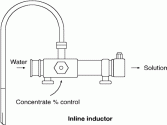
The generation of mechanical foam is simple. A definite quantity of concentrate is added to water forming a solution which is then aerated to produce finished foam. The equipment required to generate foam will include:
* A water supply of adequate pressure. This normally means a pump must be used. Some hydrant installations are capable of supplying the required quantities and pressures however.
* Hose to lead the water and solution to the point of application.
* A device to introduce the concentrate into the water stream - normally an inductor with concentrate percentage control.
* A device to aerate the solution - normally a foam-making branch.
Foam is classified by the type of concentrate or by expansion ratios.
By concentrate
Protein: hydrolysed protein (low expansion)
Fluoroprotein: protein containing fluoro-chemical additives (low expansion).
Fluoro-chemical: solution of synthetic fluoro-chemical surfactants. Also known as aqueous film forming foam. (Low expansion).
Synthetic: solution of synthetic detergents (low, medium or high expansion).
Alcohol-resistant foams: usually protein type with additives to stabilise foams used on water miscible solvents.
By expansion
Low expansion: up to 50 l of finished foam for every litre of solution used.
Usual expansion: ratio is between 5:1 and 15:1.
Medium expansion: ratios from 50:1 to 500:1 but usually between 75:1 and 150:1.
High expansion: ratios from 500:1 to 1500:1, but usually between 750:1 and 1000:1.
Foam equipment
Low and medium expansion foam equipment is most commonly used in industry. This normally includes an inline inductor which induces foam concentrate into the water stream and a foam-making branch which aerates the mixture to produce finished foam.

Most inline inductors are fitted with a foam concentrate percentage control.
Successful extinguishments
In addition to applying the foam correctly, successful extinguishment will depend on a definite quantity of foam being applied for a certain period of time. Before purchasing foam equipment those responsible should:
* Carry out a risk evaluation to determine the size of the fire likely to occur.
* Consider the type of fuel, to select the correct concentrate and determine a preferred application rate (this is normally 4 to 6 l/min/m2 of solution for hydrocarbons).
* Calculate the amount of concentrate and equipment required to extinguish the fire in a reasonable time in relation to the manpower that will be available. As a rough guide 30 min can be used for small fires and 60 min for medium size fires.
eg: Risk evaluation revealed that a spillage of petrol could result in a fire over an area of 30 m2. Four fire team members will be available.
Solution required l/min = area of fire x application rate
= 30 x 5
= 150 l/min
Amount of concentrate at 6% induction = 6% of 150
= 9 l/min
Sufficient for 30 min = 9 l x 30 min
= 270 l to be kept in stock
Equipment required = 1 x 200 l/min inductor and branch
Practical considerations
* Adequate foam stocks must be available before foam is brought into operation.
* Foam should be applied to the burning liquid as gently as practicable.
* The performance of foam generating equipment must be monitored carefully so that faults are noticed and rectified promptly.
* Clean and flush equipment thoroughly after use.
Conclusion
Some of the shortfalls noticed by FPA staff when carrying out training sessions at various industrial concerns include:
* Lack of pre-planning prior to purchase of equipment resulting in equipment being either inadequate or unsuitable for the risk.
* Equipment that is incompatible. Foam branch pipes rated at 450 l/min being supplied by inductors only capable of supplying 200 l/min or inductors having a concentrate percentage control of up to 5% while the concentrate stocked must be used at 6%, are typical examples.

* Unsatisfactory maintenance of foam equipment. Nozzles, washers, couplings and flexible connections require regular attention if the equipment is to be reliable in use.
Source: Fire Protection Association of Southern Africa

© Technews Publishing (Pty) Ltd. | All Rights Reserved.